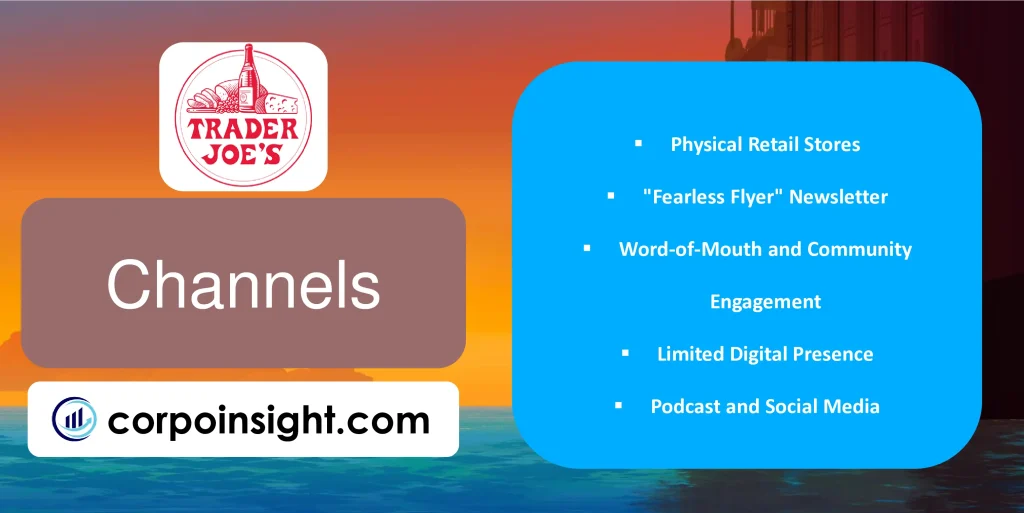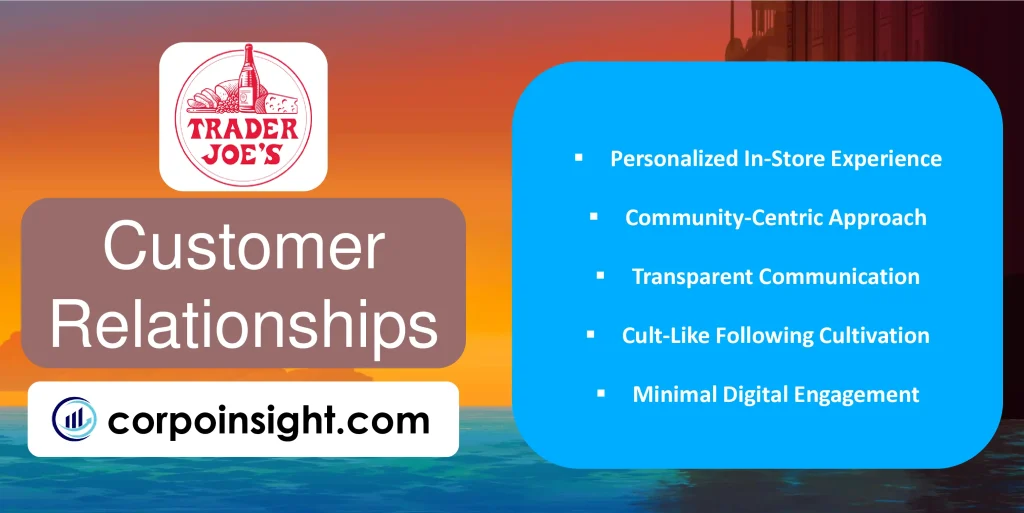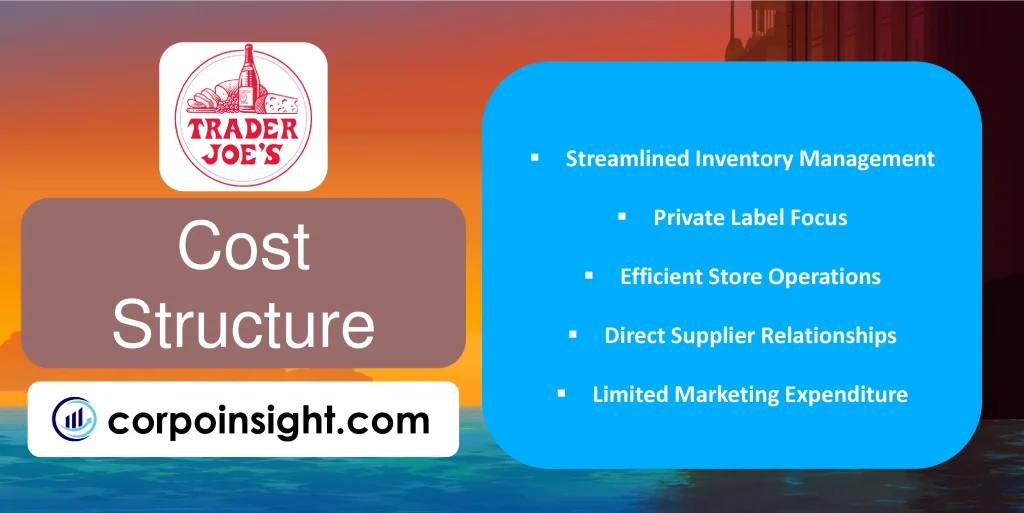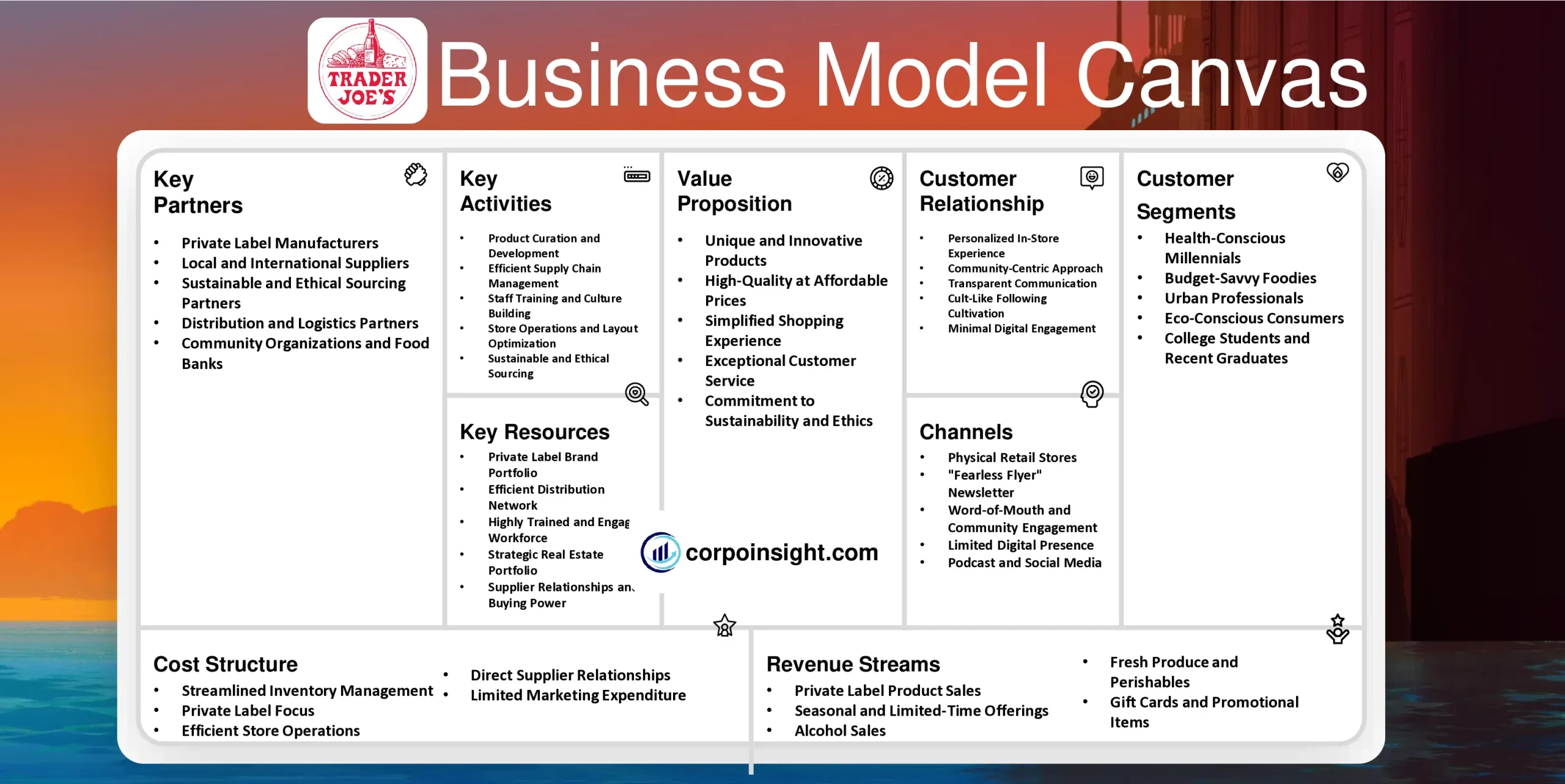Trader Joe’s Business Model Canvas 2024
Blending whimsical product names with affordable gourmet offerings, Trader Joe’s has cultivated a devoted following that eagerly anticipates each new item while cherishing longtime favorites. In this Trader Joe’s business model canvas, I will identify its customer segments, value proposition, revenue streams, channels, customer relationships, key activities, key resources, key partners, and cost structure.
Interesting fact!
The store’s nautical bell-ringing system isn’t just for ambiance. One ring calls for more cashiers, two rings for general assistance, and three for a manager.
Trader Joe’s Competitors
Whole Foods Market | Sprouts Farmers Market | Aldi | Wegmans | Costco | Target | Kroger | Safeway | Walmart | Publix
Customer Segments – Trader Joe’s Business Model Canvas

Health-Conscious Millennials: This segment, comprising a significant portion of Trader Joe’s customer base, seeks organic, non-GMO, and environmentally friendly products. They are drawn to Trader Joe’s unique offerings, such as cauliflower gnocchi and cold-pressed juices, which align with their health-focused lifestyle and culinary adventurousness.
Budget-Savvy Foodies: Attracted by Trader Joe’s ability to offer gourmet and international foods at competitive prices, this segment includes culinary enthusiasts from various age groups who appreciate quality without breaking the bank. They relish in discoveries like truffle-infused olive oil or imported cheese selections that would typically command higher prices elsewhere.
Urban Professionals: Time-strapped city dwellers form a crucial segment for Trader Joe’s, gravitating towards the store’s convenient locations and efficiently packaged prepared meals. This group values the balance of quality and convenience offered by products such as pre-cut vegetables, ready-to-eat salads, and frozen ethnic cuisines that cater to their fast-paced lifestyles.
Eco-Conscious Consumers: With sustainability becoming increasingly important, this growing segment appreciates Trader Joe’s efforts to reduce plastic packaging and offer more environmentally friendly options. They are particularly drawn to the company’s expanding range of plant-based products and its commitment to ethical sourcing practices, which resonate with their values.
College Students and Recent Graduates: This price-sensitive yet quality-seeking segment finds Trader Joe’s an ideal shopping destination, thanks to its affordable staples and unique snacks. The store’s compact size, coupled with its curated selection of easy-to-prepare meals and budget-friendly wine options, caters perfectly to their needs and limited resources.
Value Proposition – Trader Joe’s Business Model Canvas

Unique and Innovative Products: Trader Joe’s distinguishes itself by offering a curated selection of distinctive, often exclusive products that cater to evolving consumer tastes and preferences. From cauliflower gnocchi to Everything But the Bagel seasoning, these innovative items create a sense of discovery and excitement for shoppers, encouraging frequent visits to explore new offerings.
High-Quality at Affordable Prices: By leveraging private-label products and maintaining efficient operations, Trader Joe’s delivers premium-quality goods at competitive prices. This value proposition is exemplified by their ability to offer organic produce, artisanal cheeses, and unique international foods at costs significantly lower than specialty stores, without compromising on quality.
Simplified Shopping Experience: In contrast to overwhelming supermarket environments, Trader Joe’s provides a streamlined shopping experience with a compact store format and a carefully curated inventory of approximately 4,000 items. This approach not only reduces decision fatigue for customers but also ensures higher turnover rates, maintaining product freshness and reducing waste.
Exceptional Customer Service: Trader Joe’s invests heavily in its staff, known as “Crew Members,” who are renowned for their product knowledge, friendliness, and willingness to assist customers. This commitment to service excellence, coupled with the store’s informal and welcoming atmosphere, fosters a loyal customer base that values the personalized shopping experience.
Commitment to Sustainability and Ethics: Responding to growing consumer concerns, Trader Joe’s has strengthened its value proposition by emphasizing sustainability initiatives and ethical sourcing practices. From reducing plastic packaging to expanding its range of plant-based options and ensuring fair labor practices in its supply chain, the company aligns its operations with the values of its environmentally and socially conscious customers.
Revenue Streams – Trader Joe’s Business Model Canvas

Private Label Product Sales: The cornerstone of Trader Joe’s revenue stream, private label products account for approximately 80-90% of their offerings. This strategy allows the company to maintain control over pricing and quality while offering unique items like Cookie Butter and Unexpected Cheddar, which drive customer loyalty and repeat purchases.
Seasonal and Limited-Time Offerings: Trader Joe’s leverages the power of scarcity and seasonality to boost sales, introducing temporary products that create urgency and excitement among shoppers. From pumpkin-flavored items in fall to holiday-themed treats, these limited-time offerings not only generate substantial revenue but also encourage frequent store visits as customers seek to catch these fleeting products.
Alcohol Sales: In states where regulations permit, Trader Joe’s generates significant revenue from its curated selection of wines, beers, and spirits. The famous “Two-Buck Chuck” wine, along with other private-label alcoholic beverages, contributes substantially to the company’s bottom line, appealing to both budget-conscious consumers and those seeking unique, affordable options.
Fresh Produce and Perishables: While not the largest segment, sales of fresh produce, meats, cheeses, and other perishables constitute an important revenue stream. Trader Joe’s strategic sourcing and efficient inventory management allow them to offer competitive prices on these items, which often serve as drivers for customer visits and complement their packaged goods sales.
Gift Cards and Promotional Items: Although a smaller revenue stream, the sale of gift cards and Trader Joe’s branded merchandise, such as reusable shopping bags and seasonal items, contributes to the company’s income. These products not only generate direct revenue but also serve as marketing tools, enhancing brand loyalty and visibility beyond the store environment.
Channels – Trader Joe’s Business Model Canvas

Physical Retail Stores: The primary channel for Trader Joe’s, with over 530 locations across 43 states as of 2024, are strategically positioned in high-traffic urban and suburban areas. These compact, efficiently designed stores serve as the cornerstone of the company’s distribution strategy, offering a curated shopping experience that sets Trader Joe’s apart from traditional supermarkets.
“Fearless Flyer” Newsletter: This quirky, informative publication, available both in print and digital formats, serves as a crucial marketing channel for Trader Joe’s. Combining product highlights, recipes, and the brand’s distinctive humor, the Fearless Flyer not only drives foot traffic to stores but also reinforces the company’s unique personality and keeps customers informed about new and seasonal offerings.
Word-of-mouth and Community Engagement: Leveraging its cult-like following, Trader Joe’s relies heavily on customer advocacy and community involvement as a channel for brand expansion. By fostering a sense of discovery and encouraging customers to share their favorite products, the company effectively turns its loyal shoppers into brand ambassadors, driving organic growth through personal recommendations.
Limited Digital Presence: While Trader Joe’s maintains a minimalist approach to e-commerce, its website and mobile app serve as informational channels, providing store locations, product information, and recipes. This strategy, though unconventional in the digital age, aligns with the company’s focus on in-store experiences and helps maintain the sense of discovery that characterizes the Trader Joe’s shopping experience.
Podcast and Social Media: Trader Joe’s has expanded its channels to include a podcast, “Inside Trader Joe’s,” and carefully curated social media accounts. These platforms offer behind-the-scenes insights, product spotlights, and customer engagement opportunities, serving as extensions of the brand’s unique voice and fostering a deeper connection with its audience without compromising its low-key marketing approach.
Customer Relationships – Trader Joe’s Business Model Canvas

Personalized In-Store Experience: Trader Joe’s fosters strong customer relationships through its highly trained and friendly “Crew Members,” who are empowered to engage with customers, offer product recommendations, and even open packages for sampling. This approach creates a personalized shopping experience that builds trust and loyalty, setting Trader Joe’s apart from impersonal big-box retailers.
Community-Centric Approach: By tailoring product offerings to local tastes and engaging in community events, Trader Joe’s cultivates a sense of belonging among its customers. The company’s practice of donating unsold, consumable food to local food banks not only reduces waste but also strengthens its reputation as a socially responsible neighbor, deepening customer affinity.
Transparent Communication: Trader Joe’s maintains an open dialogue with customers through various channels, including its “Fearless Flyer” newsletter, podcast, and product feedback mechanisms. By explaining the rationale behind product decisions, such as discontinuations or ingredient changes, and actively seeking customer input, the company builds trust and makes customers feel valued and heard.
Cult-Like Following Cultivation: Through its unique product offerings, quirky marketing, and consistent shopping experience, Trader Joe’s has nurtured a devoted customer base that often takes on characteristics of a fan community. This relationship is reinforced by limited-time and seasonal offerings that create a sense of excitement and urgency, encouraging frequent visits and social media sharing among enthusiasts.
Minimal Digital Engagement: Unlike many retailers, Trader Joe’s maintains a deliberately low-key digital presence, focusing instead on in-person interactions. This strategy, while unconventional, reinforces the company’s commitment to personal connections and the in-store experience, appealing to customers who value authenticity and human interaction over digital convenience in their shopping relationships.
Key Activities – Trader Joe’s Business Model Canvas

Product Curation and Development: Trader Joe’s distinguishes itself through rigorous product selection and innovative private-label development, which involves identifying emerging food trends, collaborating with suppliers to create unique offerings, and conducting extensive taste tests. This activity results in a constantly evolving product line that includes items like Cauliflower Gnocchi and Everything But The Bagel seasoning, driving customer excitement and repeat visits.
Efficient Supply Chain Management: By maintaining direct relationships with suppliers and eliminating middlemen, Trader Joe’s optimizes its supply chain to keep costs low while ensuring product quality and freshness. This key activity enables the company to offer premium products at competitive prices, as exemplified by their ability to sell organic produce and specialty items at significantly lower costs than competitors.
Staff Training and Culture Building: Trader Joe’s invests heavily in employee training and fostering a positive work culture, which translates directly into superior customer service. The company’s commitment to this activity is evident in its above-average wages, comprehensive benefits, and promotion-from-within policy, resulting in knowledgeable, enthusiastic staff who significantly enhance the shopping experience.
Store Operations and Layout Optimization: Trader Joe’s continually refines its store operations and layout to maximize efficiency and enhance the customer experience. This activity involves strategically arranging products to encourage discovery, maintaining a compact store format to reduce overhead costs, and implementing efficient checkout processes, all of which contribute to the brand’s unique, hassle-free shopping environment.
Sustainable and Ethical Sourcing: In response to growing consumer concerns, Trader Joe’s has intensified its focus on sustainable and ethical sourcing practices. This key activity includes initiatives to reduce plastic packaging, expand organic and plant-based offerings, and ensure fair labor practices throughout its supply chain, aligning the company’s operations with its customers’ values and enhancing its brand reputation.
Key Resources – Trader Joe’s Business Model Canvas

Private Label Brand Portfolio: Trader Joe’s extensive private label portfolio, accounting for approximately 80% of its products, serves as a critical resource that differentiates the company from competitors. This unique collection of products, ranging from innovative frozen meals to specialty snacks, not only ensures higher profit margins but also fosters customer loyalty through exclusive offerings.
Efficient Distribution Network: Trader Joe’s leverages a streamlined distribution system, utilizing regional warehouses and direct-to-store delivery for perishables, which enables the company to maintain lower prices and ensure product freshness. This network, coupled with their strategy of limiting SKUs to around 4,000 items per store, allows for nimble inventory management and rapid product turnover.
Highly Trained and Engaged Workforce: Trader Joe’s employees, known as “Crew Members,” represent a vital resource that embodies the company’s culture and drives customer satisfaction. By investing in comprehensive training programs, offering competitive wages, and fostering a positive work environment, Trader Joe’s cultivates a workforce that is knowledgeable, enthusiastic, and integral to the brand’s unique shopping experience.
Strategic Real Estate Portfolio: With over 530 stores in prime urban and suburban locations as of 2024, Trader Joe’s carefully curated real estate portfolio serves as a key resource. The company’s selective approach to store placement, favoring high-traffic areas with specific demographic characteristics, ensures optimal store performance and reinforces the brand’s accessibility to its target customer segments.
Supplier Relationships and Buying Power: Trader Joe’s has cultivated strong, direct relationships with suppliers, which, combined with its significant buying power, enables the company to secure high-quality products at competitive prices. This resource allows Trader Joe’s to maintain its value proposition of offering unique, premium products at affordable price points, contributing to its strong market position in the specialty grocery sector.
Key Partners – Trader Joe’s Business Model Canvas

Private Label Manufacturers: Trader Joe’s relies heavily on partnerships with various food manufacturers who produce their private label products, which constitute approximately 80% of their inventory. These partnerships, often shrouded in secrecy to maintain competitive advantage, enable Trader Joe’s to offer unique, high-quality products at competitive prices, such as their popular Mandarin Orange Chicken produced by a leading Asian food manufacturer.
Local and International Suppliers: To maintain its diverse and unique product offerings, Trader Joe’s cultivates relationships with both local and international suppliers. These partnerships allow the company to source specialty items, like their Italian Truffle Cheese or Chilean Olive Oil, directly from producers, ensuring quality control and enabling Trader Joe’s to offer these premium products at lower prices than competitors.
Sustainable and Ethical Sourcing Partners: In response to growing consumer demand for sustainability, Trader Joe’s has strengthened partnerships with suppliers committed to ethical and environmentally friendly practices. These collaborations have resulted in initiatives such as reducing plastic packaging, expanding organic offerings, and ensuring fair labor practices throughout the supply chain, enhancing the company’s reputation for social responsibility.
Distribution and Logistics Partners: Trader Joe’s operates a lean distribution network, partnering with regional warehouses and transportation companies to ensure efficient product delivery to its stores. These strategic partnerships, combined with the company’s limited SKU model, enable Trader Joe’s to maintain lower operational costs and ensure product freshness, contributing to its ability to offer competitive pricing.
Community Organizations and Food Banks: Trader Joe’s maintains partnerships with local food banks and community organizations as part of its commitment to reducing food waste and supporting local communities. Through these partnerships, the company donates unsold, consumable food items, which not only addresses food insecurity but also strengthens Trader Joe’s position as a socially responsible corporate citizen, enhancing its brand image and customer loyalty.
Cost Structure – Trader Joe’s Business Model Canvas

Streamlined Inventory Management: Trader Joe’s maintains a lean inventory of approximately 4,000 SKUs per store, significantly less than traditional supermarkets, which allows for reduced storage costs, minimized waste, and increased turnover rates. This efficient inventory management, coupled with their practice of selling products in smaller packages, contributes to lower overall operational costs and enables competitive pricing.
Private Label Focus: By emphasizing private label products, which constitute around 80% of their offerings, Trader Joe’s significantly reduces costs associated with marketing and brand premiums. This strategy not only increases profit margins but also allows the company to maintain control over production costs and quality, resulting in savings that can be passed on to consumers through lower prices.
Efficient Store Operations: Trader Joe’s employs a no-frills approach to store design and operations, favoring smaller store formats (averaging 10,000-15,000 square feet) in strategic locations. This approach, combined with minimal in-store technology and a focus on cross-trained employees, reduces overhead costs related to rent, utilities, and specialized labor, contributing to the company’s overall cost-effective structure.
Direct Supplier Relationships: By cultivating direct relationships with suppliers and eliminating middlemen, Trader Joe’s optimizes its supply chain costs. This approach not only reduces expenses associated with traditional distribution channels but also allows for better negotiation of prices and terms, enabling the company to secure high-quality products at lower costs.
Limited Marketing Expenditure: Unlike many retailers, Trader Joe’s maintains a remarkably low marketing budget, relying primarily on word-of-mouth and its “Fearless Flyer” newsletter for promotion. This strategic decision to forgo expensive advertising campaigns and loyalty programs significantly reduces marketing costs, allowing the company to allocate more resources to maintaining competitive prices and investing in product quality.
Summary of Trader Joe’s Business Model Canvas

Conclusion on Trader Joe’s Business Model Canvas
Trader Joe’s business model canvas reveals a meticulously crafted strategy that leverages unique product offerings, efficient operations, and strong customer relationships to create a distinctive position in the grocery market. By focusing on private label products, maintaining a lean inventory, cultivating direct supplier relationships, and prioritizing customer experience, Trader Joe’s has built a cost-effective structure that enables competitive pricing. This approach, combined with a curated shopping experience and community-centric values, has fostered a loyal customer base and sustained the company’s growth in a highly competitive industry.

I’m Samin Yasar, currently working as a Brand Strategist for one of the world’s leading Prop Firms. I have a passion for content creation and dream of making my own film one day.







